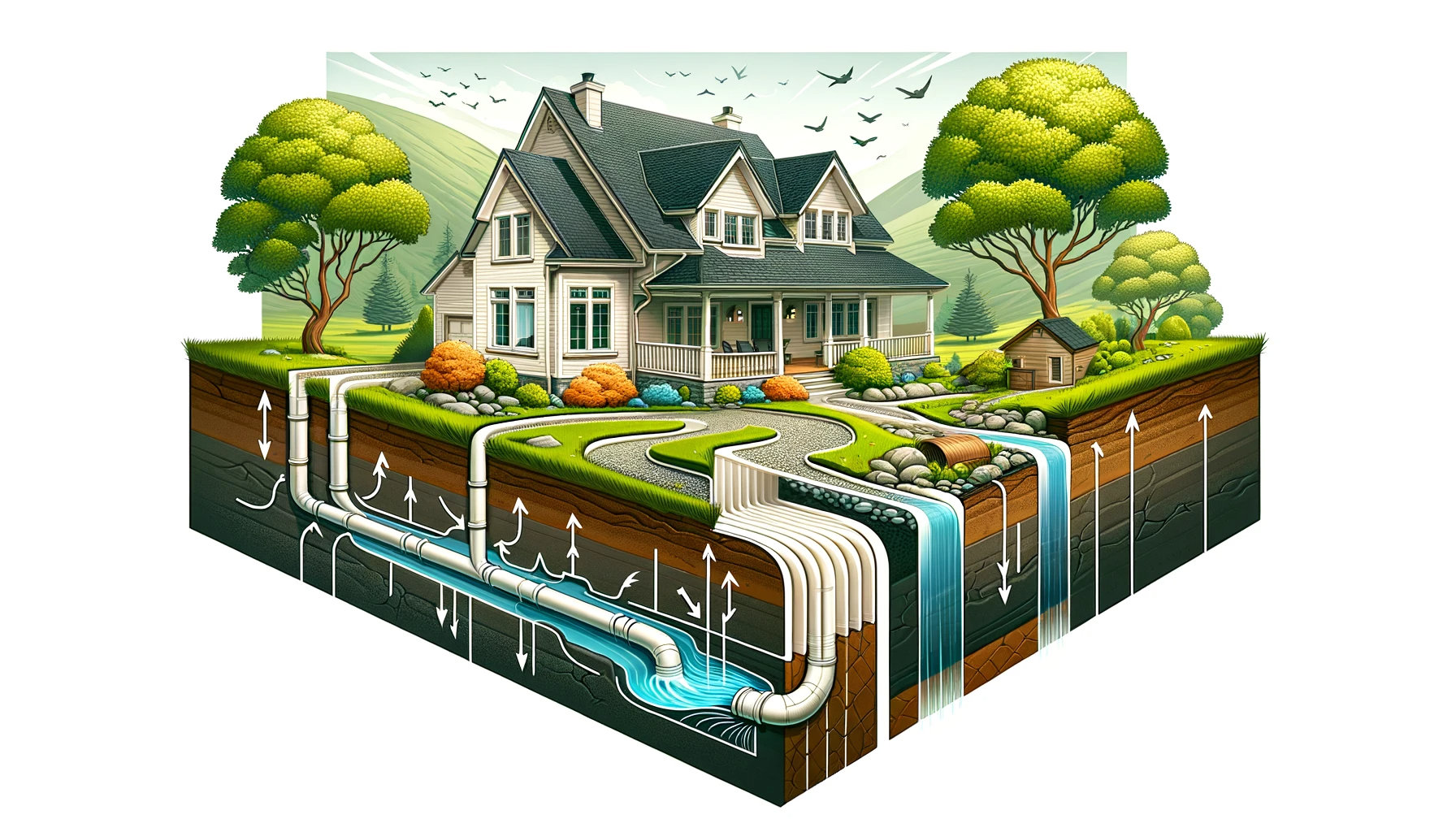Mastering Drain Grading: A Homeowner’s Pathway to Efficient Water Management

Welcome to our comprehensive Homeowner’s Guide to Drain Grading. Understanding the intricacies of drain grading is imperative for every homeowner. Why? Because the slope of your property directly impacts its drainage efficiency and, subsequently, the long-term integrity of your home structure. Improper drainage can lead to a myriad of issues, ranging from minor nuisances to serious foundational damage.
We, at DrainFixPros, recognize the concerns and challenges homeowners face when dealing with water management on their property. With this guide, we aim to empower you with knowledge and practical advice to ensure that your home’s drainage system is functional and effective, avoiding common complications such as water seepage, basement flooding, and soil erosion. Begin your journey to a water-wise home by familiarizing yourself with the fundamentals of drain grading.
| Potential Consequences of Poor Drain Grading | Impact on Property |
|---|---|
| Foundation Damage | Leads to costly repairs and structural woes |
| Erosion | Destabilizes the landscape and outdoor areas |
| Mosquito Breeding Grounds | Increases health hazards and discomfort |
| Over-saturation of Soil | Affects vegetation and can uproot plants |
Remember, a well-executed drain grading project can be a rewarding DIY endeavor, protecting your investment in the long run. Browse through our comprehensive resources on understanding residential drains for an in-depth understanding.
What is Drain Grading?
Drain grading, simply put, is the process of configuring the slope of land away from your home’s foundation to encourage proper water flow. The aim? To prevent water from pooling around your home, which can cause significant damage over time. Drain grading is crucial, as water that stagnates near your home’s foundation can lead to a compromised structural integrity.
Understanding the importance of slope in your property’s grading cannot be overstated. This is often measured as a percentage representing the incline degree, with a minimum slope of 2% (or a 1/4 inch per foot drop) being ideal for effective drainage. Let’s break down slope grading types:
- Positive Grading: Slopes away from the house, directing water to the yard or storm drains.
- Negative Grading: Slopes toward the house, potentially causing water to pool near the foundation.
- Flat Grading: Lacks sufficient slope, often leading to stagnant water and the consequences that follow.
Proper grading should always lead water away from your home to avert the risks discussed. For expert guidance on the types of home drainage systems that complement your grading efforts, be sure to read our article on types of home drainage systems.
Assessing Your Yard’s Drainage Issues
Before altering your property’s grading, it’s crucial to assess whether you actually face any drainage issues. Here are a few tell-tale signs that your yard might be poorly graded:
- Puddles forming on your lawn or near the home’s foundation after rain.
- Erosion marks, where soil or mulch is washed away by runoff.
- Dampness in basements or crawl spaces, often a sign of water infiltration.
Should you observe these clues, it’s time to take action. Here’s a straightforward method to measure your yard’s current slope:
- Place a stake at the house’s foundation and another where you suspect water pools.
- Tie a string at a consistent height from the ground between the two stakes.
- Use a level to adjust the string until it’s flat and measure the distance from the string to the ground at the second stake.
- The difference in height will reveal your slope; a lower second stake indicates positive grading, while a higher signifies negative grading.
For precision and optimal results, a professional grade slope gauge or leveling instrument is recommended.
Recommended Yard Slope for Proper Drainage
| Area | Recommended Slope |
|---|---|
| Near the foundation | Minimum 2% (1/4 inch per foot) |
| Garden or Lawn | 1-2% for healthy grass and plant draining |
| Driveways and Walkways | 1.5-2% to prevent water accumulation |
Should you require expert assistance or advanced solutions, our article on DIY drain installation offers valuable insights for tackling drain issues systematically.
Tools and Materials for Drain Grading
To embark on a successful drain grading project, you’ll need a collection of tools and materials that are essential to reshape your landscape effectively. Here’s a list of what you should have in your arsenal:
- Shovels: For digging and moving soil.
- Wheelbarrow: To transport dirt and debris.
- Stakes and String: To mark out the slope.
- Level or Slope Gauge: To measure the grade accurately.
- Fill Dirt: Preferably topsoil or a soil mix that compacts well.
Tool Purpose and Usage
| Tool | Purpose | Usage Tips |
|---|---|---|
| Shovel | Digging and moving soil | Use a square shovel for edging and a round one for digging. |
| Wheelbarrow | Transporting materials | Ensure it’s well-balanced for easier handling. |
| Stakes and String | Marking areas for grading | Place stakes at key points to outline desired slope. |
| Level/Slope Gauge | Measuring slope accuracy | Use it to ensure you’re achieving the needed incline. |
| Fill Dirt | Building up the graded area | Compact in layers to prevent settling and erosion. |
Having gathered your materials, you may also want to peruse our articles on common drain problems to anticipate any challenges you might encounter during your project.
DIY Drain Grading Steps
Performing DIY drain grading can be a rigorous but rewarding process. To help you get started, we’ve outlined a series of steps that we encourage homeowners to follow:
- Plan Your Approach: Based on your assessment, determine where the highest and lowest points of your property should be.
- Mark the Slope: Place stakes at the foundation and at various distances away. Use string to create a visual line that will guide your grading.
- Dig and Fill: Excavate where necessary and add soil to areas that require building up. Ensure that the fill dirt is well-compacted and even.
- Check the Slope: Regularly use your level or slope gauge to make sure the slope is consistent with the string guide.
- Create Swales or Drains: As needed, construct channels to direct water away from your home, incorporating solutions like French drains for better water management.
Safety Considerations during Grading
| Consideration | Recommended Action |
|---|---|
| Personal Protection | Wear gloves, sturdy boots, and protective eyewear. |
| Workload Management | Take breaks and drink water to avoid exhaustion. |
| Machinery Use | Only operate machinery you’re trained to use safely. |
| Posture | Use ergonomic lifting techniques to prevent injuries. |
| Weather Considerations | Avoid working in extreme heat or during storms. |
Through every step of the process, keep safety at the forefront, and remember, if you’re considering a complete drainage overhaul, our guides on drain maintenance tips and DIY drain repair will provide critical insights to ensure your system remains in peak condition.
Landscaping Considerations for Drain Grading
Landscaping isn’t just about aesthetics; it plays a pivotal role in maintaining an effective drainage system. When planning your yard’s layout, consider these factors that can influence water flow:
- Plant Placement: Plants and trees should be positioned to facilitate, not hinder, water movement away from your home.
- Garden Beds: Raised beds can help direct water flow, but ensure they’re not obstructing the graded slope.
- Hardscaping: Patios and walkways must be constructed with a slight pitch to contribute to the overall drainage plan.
Tips for Drainage-friendly Landscaping Design
| Landscaping Element | Tips for Drainage |
|---|---|
| Plants & Trees | Use deep-rooted species to absorb excess water and prevent soil erosion. |
| Mulch and Soil | Select types that allow proper water infiltration and provide good drainage. |
| Hardscaping | Install with attention to slope to prevent water pooling and direct runoff. |
For complex landscaping designs that could impact drainage, consider consulting with a professional. Dive deeper into how you can enhance your property’s value while improving drainage with our article on landscaping and drainage.
Preventive Maintenance for Drain Grading
Keep your drain grading in check with regular maintenance. Here’s what to watch for to avoid future drainage dilemmas:
- Inspect Drain Systems: Check for any signs of blockage or damage.
- Gutter and Downspout Care: Ensure they are clear of debris and direct water adequately away from your home.
- Monitor Downspout Extensions: They should be intact and extend far enough to channel water effectively.
Checklist for Regular Maintenance
- Biannual drain system inspections.
- Seasonal gutter cleaning.
- Post-storm checks for erosion or settling.
Regular maintenance contributes to the longevity and functionality of your accessible solutions, such as downspouts and gutters. Our gutter downspout tips offer practical advice to further this cause.
Advanced Drainage Solutions
Sometimes, basic drain grading might not suffice; it’s these moments that call for advanced drainage solutions. When dealing with high rain volume or specific soil types, additional measures become necessary:
- Installation of French Drains: To redirect sub-surface water.
- Sump Pumps: For areas prone to heavy pooling or flooding.
- Dry Wells: Absorbing and dispersing water deeper into the ground.
These solutions cater to different aspects of water management and your yard’s unique demands. Moving towards more sophisticated solutions like smart home systems could be pivotal in optimal water management. Engage with our articles discussing smart home drainage and basement drainage solutions for an understanding of when specialized installations may be beneficial.
When to Consider Advanced Drainage Options
| Issue | Advanced Solution | Consideration |
|---|---|---|
| Persistent Flooding | Sump Pumps | Effective in basements and low-lying areas. |
| Large Yard Area | Dry Wells | Ideal for spreading water over a wider area. |
| Sub-Surface Water | French Drains | Excellent for redirecting underground moisture. |
Drain Grading and Environmental Sustainability
When we consider drain grading in our yards, it’s essential to factor in the broad aspect of environmental sustainability. Adopting eco-friendly practices not only aids in preserving the local ecosystem but also ensures that our methods are future-proof.
- Soil Conservation: Prevent erosion by stabilizing graded areas with vegetation.
- Water Management: Utilize rain barrels and other collection systems to reduce runoff.
- Permeable Paving: Opt for materials that allow water to seep through, thereby replenishing groundwater.
Sustainable Practices in Drain Grading
| Practice | Benefit | Implementation Tip |
|---|---|---|
| Rain Gardens | They filter runoff and support biodiversity. | Choose native plants that require minimal maintenance. |
| Permeable Surfaces | They reduce surface runoff and replenish aquifers. | Incorporate them in patios and driveways. |
| Natural Swales | They guide water flow and enhance landscape aesthetics. | Designate areas where water naturally collects. |
To delve into more eco-conscious options and their impact on your property’s value and appeal, our resource on eco-friendly drain solutions is a must-read.
Understanding Local Regulations and Drainage Laws
Adhering to local regulations is a critical component of property maintenance and development. Before commencing with any grading or landscaping work, ensure compliance with:
- Building Codes: These might dictate specific slopes and materials.
- Zoning Laws: Your project must conform to your area’s zoning requirements.
- Environmental Regulations: Certain areas may have restrictions to protect the environment.
Educating yourself on local laws will safeguard you from potential legal issues. Should questions arise, it’s advised to consult with a professional. For further insight, consider exploring our article on legal drainage systems.
The Cost-Benefit Analysis of Drain Grading
Drain grading is an investment in your property’s longevity and habitability. While there are upfront costs to consider, the long-term benefits are substantial:
- Foundation Protection: Reduces the risk of costly foundational repairs.
- Landscape Preservation: Avoids the expenses associated with erosion and plant loss.
- Increased Home Value: A well-graded property is more appealing and valuable to potential buyers.
Calculating the cost-effectiveness of your drainage project is crucial. Our expert article on cost-effective drainage offers a framework for understanding the financial implications.
Hiring Professionals vs. DIY for Drain Grading
Finally, deciding between taking on the grading project yourself or hiring a professional service is a crucial choice. Each has merits and potential drawbacks:
- DIY: Cost-effective and rewarding, but time-consuming and potentially less accurate without professional tools.
- Professional: More expensive, but comes with expert knowledge, precision, and often a service guarantee.
Consider not only the financial aspect but also the complexity of your project and your personal expertise. Our guide on choosing a drainage contractor can assist in making an informed decision.
Conclusion
In our Homeowner’s Guide to Drain Grading, we have navigated the nuances of proper drain grading, from assessing yard drainage issues to exploring advanced drainage solutions. The responsibility to protect our homes from water damage through effective grading cannot be overstated. It is an imperative step in safeguarding the foundation of your property and enhancing its overall value.
We encourage you to approach this task with diligence and foresight. Whether you’re undertaking a DIY project or opting for a professional’s touch, remember that the security and structural integrity of your home may well depend on these efforts. For any additional questions or concerns, feel free to peruse our wealth of articles on drainage solutions and property maintenance.
Key Takeaways
| Key Point | Summary |
|---|---|
| Importance of Proper Drain Grading | Essential for foundation protection and preventing water damage. |
| Signs of Drainage Issues | Puddles, erosion, and damp crawl spaces can indicate problems. |
| Necessary Tools | Shovels, wheelbarrow, stakes, string, level, and fill dirt required. |
| Steps for DIY Drain Grading | Plan slope, mark area, adjust terrain, check levels, and maintain. |
| Landscaping and Drainage | Choose plants and materials that support efficient water management. |
| Regular Maintenance | Inspect and clean drainage systems to preserve grading. |
| Advanced Drainage Should the Need Arise | Solutions like French drains and sump pumps for complex situations. |
FAQ
- What is the ideal slope for drain grading?
- Aim for at least a 2% slope (a 1/4 inch per foot drop) away from your home for effective drainage.
- Can landscaping affect my home’s drainage?
- Yes, plant placement, garden beds, and hardscaping should all be designed to aid in proper drainage.
- How often should drainage systems be inspected?
- It is recommended to inspect your drainage systems biannually and clean gutters seasonally.
- When should I consider hiring a professional for drain grading?
- If the project is complex, involves large-scale changes, or if you’re not confident in your DIY skills, a professional may be warranted.
Additional Resources
For those who wish to dive deeper into specific topics, we offer an array of resources:
- Emergency Drainage Solutions: When immediate intervention is required.
- Solving Yard Drainage: Addressing larger yard issues comprehensively.
- Seasonal Drainage Care: Preparing your home for different seasons.
We trust that this guide has equipped you with the knowledge necessary to tackle your drain grading with confidence. If you have found this guide helpful or if there is more we can offer on this topic, please let us know how we can assist you further.




